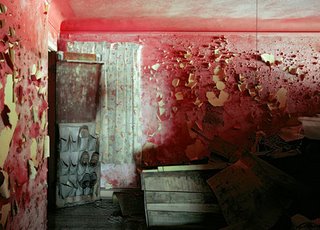Today has been all about surprises for LondonArtGirl. It started off when I was surfing the web and found out that the Royal College of Art was having a student interim show. Now, if you are a loyal reader of LAG then you know how much I love student shows. They are the perfect opportunity to gauge future talent and formulate your own opinion before the critics and tastemakers have their say. The last couple of student shows I have visited were okay, but generally I wasn’t bowled over. However, this show was different. The quality of the work was consistently higher and there was simply more of it.
Now here comes the bad part. Perhaps indicative of the current contemporary art market, the prices were rather…ahem… steep for a student show. Once upon a time, these shows were a great place for novice collectors to get their feet wet in the art market and for savvy collectors to get some great deals. Sadly, it appears these days are gone. More importantly, however, the talent is still here. Here are some of the works that caught my eye.

The first work I saw in the front room was a large canvas titled “Take Me Madonna” by Simon Collins. You need to take your time with this one because there is a lot going on here. The work is expertly rendered in a realist style – although I don’t know how likely you are to see this scene in reality. On the left side of the canvas, there is a bare-breasted woman seated with her legs partially open and her head arbitrarily cropped out of the composition. In the background there is a woman gazing warmly at something or someone that is not clear to the viewer. To the right is a masked man kneeling over a nun wearing only her habit and clutching a rosary. Both the nun and the masked man are staring out at the viewer as if to dare them to look at the provocative and sexually charged image. There is no shame in their eyes, only intensity. Perhaps that is what makes this work so engaging. Moving on…

What first caught my eye in Ryan Mosley’s “Understanding the Quarry” was his fluid use of brushstrokes and the earth tone palette. The triangular composition shows 6 figures donning dunce caps in the foreground watching a human pyramid assembled in front of them. The figures facing the viewer are expressive rather than realistic, with some facial features defined more than others. I would love to know the story behind the subject in order to truly understand the work. Fortunately I was still able to appreciate it, if only a purely aesthetic level. And finally…

Further back in the exhibit is a large canvas by Hannah Poulson titled “The Clearing”. The artist leaves much of the canvas's foreground exposed, including the trunks of the trees. From a distance, women appear to be randomly scattered and obscured by the forest. It is only on closer examination that the figures look like models straight out of a runway show. Wearing fashionable clothes and donning a forward-looking gaze, they look like they could walk right off the canvas and into a fashion catalogue. I love the way the artist chooses a simple representation of the forest to contrast the highly detailed depiction of the figures.
Regardless of your budget, hurry up and scoot down to the Royal College of Art to check out the artists of the future before the show closes!








